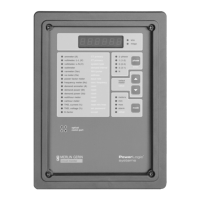Bulletin No. 3020IB9814
December 1998
62
input transition alarm conditions, the circuit monitor allows you to enter
setpoints and delays, but it ignores any values that don’t apply.
10. Press the PHASE [Enter] button.
The display alternates between “PU dLy” (an abbreviation for pickup
delay) and the delay value.
11. Use the SELECT METER [Value] buttons to increase or decrease the
displayed value until you reach the desired pickup delay (in seconds).
12. Press the PHASE [Enter] button.
The circuit monitor display alternates between “do SP” (an abbreviation
for dropout setpoint) and the setpoint value.
13. Use the SELECT METER [Value] buttons to increase or decrease the
displayed value until you reach the desired dropout setpoint.
14. Press the PHASE [Enter] button.
The display alternates between “do dLy” (an abbreviation for dropout
delay) and the delay value.
15. Use the SELECT METER [Value] buttons to increase or decrease the
displayed value until you reach the desired dropout delay (in seconds).
16. Press the PHASE [Enter] button.
The circuit monitor displays “r1 No”. “r1” stands for relay 1.
17. If you want the circuit monitor to operate relay R1 each time the alarm
condition occurs, press the up arrow SELECT METER [Value] button to
change from “No” to “Yes.” Then press the PHASE [Enter] button.
The circuit monitor displays “r2 No”.
18. If you want the circuit monitor to operate relay R2 each time the alarm
condition occurs, press the up arrow SELECT METER [Value] button to
change from “No” to “Yes.” Then press the PHASE [Enter] button.
The circuit monitor displays “r3 No”.
19. If you want the circuit monitor to operate relay R3 each time the alarm
condition occurs, press the up arrow SELECT METER [Value] button to
change from “No” to “Yes.” Then press the PHASE [Enter] button.
The display alternates between “ENAbLE” and the priority level.
20. Press the MODE button.
The circuit monitor displays “No.”
21. To save the configuration changes you just made, press the up arrow
SELECT METER [Value] button to change from “No” to “Yes.” Then
press the PHASE [Enter] button. To discard the changes, press the
PHASE [Enter] button.
The circuit monitor displays the alarm number. At this point you’ve
completed the configuration process for one alarm condition.
Detailed Setup Procedure
(cont.)

